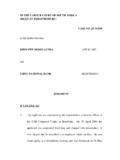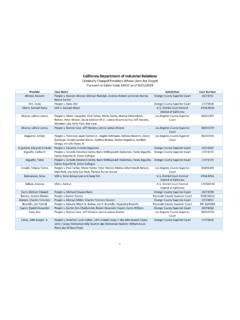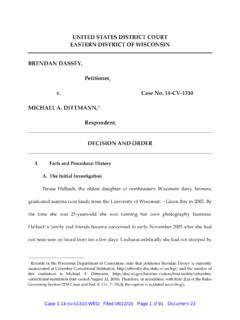Transcription of Upper Lower Crossed Syndrome1 - ChiroChat
1 Erik Dalton, Upper and Lower Crossed Syndromes Vladimir janda s Upper and Lower Crossed Syndromes are two of the most common aberrant postural patterns. Today's therapist benefit from working with janda 's Upper and Lower , or proximal-and-distal, Crossed syndrome theory when dealing with clients who suffer from neck or back pain Exposed to the same stressors certain muscles become tight and facilitated while others become weak and inhibited.. According to janda , when Upper Crossed muscles, such as the pectorals, Upper trapezius, levator scapulae, latissimus dorsi, sternocleidomastoid, anterior scalenes, suboccipitals and subscapularis are stressed, they tighten and become neurologically facilitated.
2 This category of muscles is labeled tonic, or postural. Inversely, electromyographic studies found that other Upper Crossed muscles, such as the longus capitis, longus colli, hyoids, serratus anterior, posterior rotator cuff, rhomboid major and Lower trapezius, actually weaken when exposed to the same stressors. This second set of muscles was labeled phasic, or dynamic. Amazingly, this muscular response occurs in consistent and predictable patterns regardless of the pathologic condition or the dysfunction present in the tested subjects. Typical Muscle Imbalances in the Upper Crossed Syndrome Typical Muscle Imbalances in the Lower Crossed Syndrome Tight, Facilitated: Weak, Inhibited: Tight, Facilitated: Weak, Inhibited.
3 Pectorals Upper Trapezius Levator Scapulae Sternocleidomastoid Anterior Scalenes Suboccipitals Subscapularis Latissimus Dorsi Longus Capitis & Colli Hyoids Serratus Anterior Rhomboids Lower & Middle Trapezius Posterior Rotator Cuff Iliopsoas Rectus Femoris Hamstrings Lumbar Erectors Tensor Fascia Latae Thigh Adductors Piriformis Quadratus Lumborum Rectus Abdominis Gluteals Vastus Medialis Vastus Lateralis Transversus Abdominis Abnormal afferent information may be caused by: poor posture excessive physical demands joint blockage habitual movement patterns painful or noxious stimuli CNS malregulation psychological (emotional) stressors The Upper Crossed syndrome.
4 Notice how the tight line (a) passes through the levator scapulae, Upper trapezius and the pectorals, causing shoulder elevation and scapular protraction. Inhibition in the deep neck flexors and Lower shoulder stabilizers (b) permits this asymmetry. Since the forward head is the most common postural fault seen in our society, janda 's Upper Crossed illustration is extremely helpful in visualizing exactly which muscles pull unevenly to create this distorted posture. Notice in the Upper Crossed illustration how the tight line (a in Figure ) passes through the levator scapulae, Upper trapezius and the pectorals.
5 Sustained hypercontraction in these typically tonic muscles elevates and protracts the shoulders. Conversely, one can clearly see how the deep neck flexors and Lower shoulder stabilizers that make up the weak line (b in figure) permit this asymmetry. The Lower Crossed syndrome. The tight line (a) travels through the iliopsoas and lumbar erectors, which pull and hold this aberrant swayback posture. Reciprocal inhibition weakens the abdominals and gluteals (b) allowing this dysfunctional pattern to develop. janda employs the same concepts when analyzing the Lower Crossed syndrome.
6 View how the tight line (a in Figure ) travels through the iliopsoas and lumbar erectors, while the weak line (b in Figure ) connects the abdominals and gluteals. In this Lower Crossed pattern, the short iliopsoas muscles anteriorly tilt the pelvis, creating excessive lumbar lordosis while erector spinae myofascial contractures hold this "bowing" pattern. The weak abdominals and gluteals, unable to stabilize the pelvis, allow this aberrant swayback pattern to develop. Still, a frustrating question remains: Why do so many clients present with this Lower Crossed pattern?
7 The answer is, to me, painfully obvious: flexion addiction. The last century has witnessed a dramatic acceleration in our culture's flexion addiction. This pervasive and insidious condition is primarily due to the population's generational transition from an active group of movers to a sedentary bunch of sitters. Researchers estimate that up to 75 percent of chronic neck/back pain clients will present with one or both of these Crossed patterns. Learn more about Upper and Lower Crossed Syndrome Pain Management at NEW- Dalton s Collection of Works: A compilation of Dalton's finest articles for only $ !
8 The Freedom From Pain Institute offers therapist continuing education through national seminars, state of the art videos and manuals, and certified home study programs. For more information visit 800-709-5054






